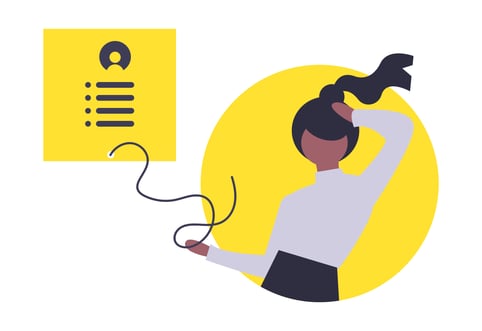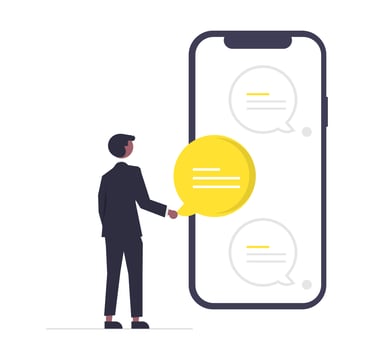A customer journey is a model that aims to simplify the description of customer decision-making. To make the abstract concreate. Customer journeys always consist of gross simplifications (not in itself a bad thing!) and differ between, for example, B2B and B2C, different industries or customer groups.
Why customer journey?
Consumer demands and expectations are growing rapidly as we become better at understanding, evaluating and consuming services and products. The interaction between consumer and supplier is increasingly digital. On average, we use ten different channels every day to interact with different businesses. It is therefore increasingly important for suppliers to understand and develop their interactions with customers. The customer's various interactions in all these contact points are usually referred to as the customer journey. The sheer number and variety of interaction channels makes it difficult to map the customer journey, which makes it harder to guarantee a good customer experience, even though it is something we absolutely must not miss. According to a recent study by Salesforce, a good customer experience is more important than ever.
-1.png)
For 80% of consumers, the interaction with the business is at least as important as the products themselves.
-1.png)
For 69% of consumers, it's important to be able to communicate with the business, where and when they need to.
-1.png)
60% of UK consumers expect a seamless customer experience across channels.
It is undoubtedly clear to us that consumers are demanding and expecting more from businesses now than ever before. How will businesses manage to live up to these high expectations? Companies need to start working with customer journey mapping to be able to meet their customers where they are in their customer journey, in order to respond to their needs.
What is a Customer Journey Map?
A Customer Journey Map is a visual presentation of your customers' journey from first interaction to a completed purchase and beyond. Your customer journey map then helps you get to know your customers by seeing which channels they are in, how they interact with your brand, where in the customer journey there is the most customer churn, etc.
Having an overview of the current situation and understanding what is driving the customer's purchase decision or decision not to buy from you, will help you improve your offer and ensure that you retain several existing customers and attract new ones.
%20(1)-1.png?width=766&height=343&name=61d594df29a3fa5efbfeff91_kunresan%20(1)%20(1)-1.png)
With the help of a customer journey map, you can identify where in the customer journey you have the most churn. With that insight, you can then test, optimize and once again analyze the customer experience and aim to reduce your churn rate.
As all companies benefit from getting to know their customers better, customer journey mapping is for all kinds of companies regardless of size and industry. It gives you as a business a chance to sort out what issues arise where and what potential pain and gain points your customers encounter. As consumer behavior and channel choices are constantly changing, it requires you as a supplier to follow their behavior and be present where and when they need you.
According to research from Salesforce, 84% of consumers are more willing to shop at companies where they have had a human and personalized treatment. This puts demands on you as a company to make sure to personalize your customers' experiences as much as possible. By personalize, we don't mean just adding the person's first name to an email, but we mean that the content sent or displayed to your customers should be adapted to where they are in their buying journey. This way you stay relevant and personalized.
Benefits of Customer Journey Mapping:
-
Help you understand the customer and adapt your communication to make it relevant and personalized
-
You can optimize the buying journey to reduce churn, for example
-
You are where your customers are and therefore more accessible
-
You get to know your target audience
-
You can satisfy their needs, increase gain points and reduce pain points

Conducting a customer journey mapping
Breaking ground can sometimes be the hardest part of a project. It is not always clear where to start "digging" and maybe not even how to "dig".
Here are 5 tips from custellence to get you started:
-
Start in an area where customer experience has an impact on key KPIs
-
Start where results can be achieved that reach the customer and make an impact on internal KPIs
-
Start with an area that you have a mandate to influence
-
Start small and limited rather than with the most important, urgent or comprehensive
-
Start at one end and show results rather than argue for a long time before you even get started
Implementation:
-
Map out all your touchpoints. This includes, for example, social media, website, e-mail, phone calls and advertisements.
-
Map your touchpoints along the customer journey based on your different personas. Different personas exist on different platforms. For example, the 16-25 age group is on Snapchat, while the 26-35 age group uses Facebook the most (source).
-
Map your personas' behavioral patterns. How do your customers behave, what questions do they have, what pain and gain points do they encounter?
-
Develop a plan on how to respond to your customers at all different stages to meet their needs in that particular phase.
Good luck with creating your customer journey map. As always, feel free to get in touch if you have any questions
Phases of the customer journey
There are many variations and names for the different phases of the customer journey, which are usually divided into the following steps.
Awareness - Consideration - Decision - (Delivery) - Advocacy
-1.png?width=872&height=157&name=61d594f08cdab4ce99fd6756_faser%20(1)-1.png)
Awareness
Here the potential customer comes to the realization that they have a need or a problem that needs to be solved (pain points). Consequently, they start a process of clarifying this need or problem until it is perceived as clear. This is done through exploratory discussions within the company, among contacts and by seeking information online.
In B2B, it can be valuable here to document the needs in a needs analysis to ensure consensus and that all needs have been captured as related to the needs insight.
Communication
To communicate with people in this phase, traditional sales pitches do not work well. Inspirational materials and simple introductions to solutions, sharing examples and problem insights can be more effective.

Consideration
In the consideration phase, insights start to emerge about the different options available to solve their needs or problems. Now it begins to be reviewed and compared based on its own criteria, which can be functional, economic (price), environmental aspects, delivery times, availability, contract terms, guarantees, etc. In the consideration phase, you begin to review and compare your options.
Here too, internal discussions take place, but the use of contact networks and the search for information on the Internet take on greater importance. The most important source of information is the network of contacts - even information first obtained from, for example, a supplier's website, is often validated by others.
In this phase, it is crucial for the customer to get the right feeling and confidence about different solutions, products or suppliers. If the right feeling is not there, the need may not be prioritized and the process may be stopped or delayed. The risks of the project are set against the status quo.
In this phase, in B2B, it may mean that someone, often a key stakeholder or the person who initially identified the need, needs to sell the project and the investment internally as roles and powers need to be appointed and, in the best case, a budget.
In B2B, it can be beneficial in this phase to create requirements and functional specifications. During this process, many customers start to create a mental list of potential solutions or suppliers. This list does not have to be explicit, but is often a few companies that are "top of mind" for the potential customer when thinking about their problem/need and its solutions.
Communication
More detailed information about products such as product sheets, product specifications, price comparisons, references or tests and comparisons are often sought here. As a supplier, it is important that there is accessible and good information about the product or service that is easy to absorb. Here, the website and its structure and content play a major role, opportunities for interaction to ask specific questions, events and webinars can be effective.

Decision
The potential customer is approaching their decision and thinks they know what they want, now it is important to be first with the right offer so that they choose you.
Here, the potential customer tends to focus on researching the suppliers' previous work, asking for customer references and asking themselves questions like:
- Do they have experience solving similar needs/problems?
- Do they have experience in the industry?
- Do they match (or at least not drastically differ) our values?
All to verify reassuring feelings and to substantiate decisions that are often already emotionally made.
Here, the client tries to appreciate the supplier's competence and asks around in their network, contacting previous clients and also reaching out to the most attractive options.
In B2B, proposals for decisions will be heavily questioned, the whole need, basis and preferred solution by those who have control functions within the company. Finance, CEO, management, steering groups who will be responsible will all do risk analysis for the company as well as for how the decision may affect their own role. How insightful and informed these control functions are can determine the whole decision and is a strong contributing factor why well-established brands and companies are often preferred as they are considered to have less risk as many others have made that choice (herd mentality).
Communication
In this phase, much is about substantiating the decision and confirming the feelings already established. A clear and good problem insight and solution proposal followed by a good offer is a good start. Quotations, contracts and sales material play a major role here. Material and communication in the form of successful customer examples, contacts with customer references, quotes can serve as positive reinforcement of the decision.

Delivery
In this phase, the product or service is delivered (as a solution or part of a solution to the need or challenge) and often also with the help of the supplier, is further clarified. The customer's experience of the outcome, the treatment and the social chemistry with the supplier culminates in feeling satisfied, dissatisfied or ambivalent.
A common psychological phenomenon is "buyers remorse", which means that as soon as a contract is signed, a bidding battle is won or a product is paid for, doubts arise as to whether the right decision was made.
Communication
Here it is important to welcome the customer early and clearly and verify that a wise and good decision has been made. Quick information with answers to questions that usually arise early on, preferably before the customer has had time to formulate them. This could be clarification on next steps, user manuals, login details, guides, etc. User groups and other ways of inviting a community can also be effective in building a solid relationship and trust early on. Personal contact can be crucial throughout the delivery phase, which is why B2B often uses delivery or customer success roles whose task is to onboard new customers and ensure that the customer experience is good.
Clarity and active, personalized communication is important throughout the delivery phase, whether it is frequent updates on expected delivery date, next steps or delivered results.

Advocacy
The goal is to create satisfied customers where the relationship lives on over time, leading to increased revenue and profits. Unfortunately, the trend is for customers to become less loyal and switch suppliers and brands more frequently (source: forbes; verint systems). The less satisfied the customer is, the more likely they are to go elsewhere.
-
A customer is 4 times more likely to switch to a competitor if the problem is service-related than price or product-related - Bain & Company.
-
The probability of selling to an existing customer is 60 - 70%. The probability of selling to a new prospect is 5-20% - Marketing Metrics.
-
For every customer complaint, there are 26 other dissatisfied customers who have remained silent - Lee Resource.
-
A dissatisfied customer will tell between 9-15 people about their experience. About 13% of dissatisfied customers tell more than 20 people - White House Office of Consumer Affairs.
-
Happy customers who get their problem resolved will tell 4-6 people about their experience. - White House Office of Consumer Affairs.
The satisfied client is not only open to doing more business, but is more likely to side with the supplier when asked - even if they are not currently in or able to enter into a business relationship with the supplier. This could be sharing the collaboration for a case, or openly sharing their experience if approached by prospective clients who are themselves researching the supplier's previous projects. In the best case, the relationship is good enough that the supplier is top of mind to the extent that the client speaks well of the company without being asked directly.
Communication
Continued personal relationship and communication even after the financial relationship has ended.

Sources:
-
Philip Kotler, Hermawan Kartajaya & Iwan Setiawan, 2017. Marketing 4.0 - Moving from traditional to digital, Wiley: Hoboken.
-
Christian Grönroos, 2016. Service Management and Marketing: Managing the Service Profit Logic. 4th ed. Wiley: Hoboken.
-
Salesforce: https://www.salesforce.com/se/blog/2020/11/vad-aer-customer-journey-mapping---varfoer-aer-det-viktigt-.html
-
https://beyondphilosophy.com/15-statistics-that-should-change-the-business-world-but-havent/

-1.jpeg?width=1280&height=720&name=61a37f2b8a666d03e34fbe17_61a0a06512b5052136fe7294_heidi-fin-M2Kxb80gqcc-unsplash%20(1)-1.jpeg)





